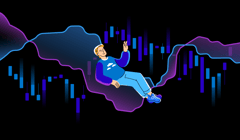
These days, markets are highly volatile. Any rise in volatility in the Forex market can increase speculation, which in turn leads to an increase in buying and selling activity. So, what exactly is volatility? In this article, we explain what volatility is, where it comes from, and how to use it to your advantage.
Contents:
- What is volatility?
- Where does volatility come from?
- Using volatility to your advantage
- Common strategies for news trading
- Riding the wave
Interact with the underlined words and green dots to get additional details and explanations.
Additional context for the visuals.
Explanations and definitions of terms.
What is volatility?
Volatility is a measure of the amount an asset price fluctuates over a given period of time. When there are wild upward and downward swings in an asset’s price, then that asset is deemed highly volatile. Conversely, when an asset does not fluctuate much, it is said to have low volatility. In simple words, volatility shows how moody the market is.
Where does volatility come from?
Now for the burning question: What makes the market move in the short term? You probably guessed it right — economic news. There are certain kinds of economic news and releases that drive prices more than others. Some economic data releases can have a significant and lasting impact on an asset, while others may not matter at all.
Some of the economic releases and news that can spark volatility in the market include:
Nonfarm payrolls
A monthly statistic showing the number of workers in the United States, excluding those employed on farmsteads, in private homes and at nonprofit organizations. Nonfarm payrolls most strongly affect the US dollar, equities and gold.
Interest rate announcements
While every country sets its own interest rate, the one set by the United States Federal Open Market Committee affects the global market and causes interest rate changes in other countries. Interest rate announcements most strongly affect the finance and banking sectors.
Inflation
Reflected by consumer price index (CPI), the inflation rate refers to changes in the prices of goods and services over a period of time. Inflation can affect oil, emerging market stocks and fixed-interest securities.
Retail sales
An economic indicator that reflects consumer demand for both durable goods and non-durable goods. The higher the number, the stronger the consumption level in the country, and markets rise as a result. Retail sales data affects the currency, stock and derivatives markets.
Gross domestic product
GDP measures the market value of all the goods and services produced by countries. Considering that it gives an indication of economic health, a high GDP affects the entire market: Companies hire more employees and pay higher wages, which leads to consumers making more frequent and higher-value purchases.
OPEC+ meetings
The Organization of the Petroleum Exporting Countries is an organization comprising 15 key oil-producing countries that coordinates decisions on oil production and activity in the oil market. Its decisions directly affect the price of oil, which in turn affects inflation as well as the prices of goods made using petroleum-based products.
Using volatility to your advantage
It is essential to thoroughly analyze the price trend of any asset before opening a trade. Doing so helps you determine good breakout trade opportunities and avoid unnecessary risks. Along with this, keeping yourself informed on current news as it comes out may help you determine your confidence and, thus, size of the trade.
When news is about to be released, you may be able to see three different phases in the markets:
- Price movements go into a sideways pattern. This is because there is indecision on the outcome of the asset price.
- The news release occurs. A surprise result causes a sharp move in one direction or the other, breaking through formed support or resistance levels.
- The initial impulse passes. Technical analysis can be used again, allowing further price movements to be predicted and support and resistance levels to be rebuilt.
Common strategies for news trading
There are four strategies for trading alongside news announcements that any trader can use:
1️⃣ Predicting the direction of the price’s movement and entering into a market order before the news releases.
If the market reaction moves the price in a favorable direction, let it ride and be ready to take profits. But keep in mind that riding a bull or bear represents a high risk. If you want to try it out, do so with lower multiplier values to test your skills.
Here, prediction doesn’t mean choosing a random price direction to trade in. Instead, it is an informed decision on whether to trade alongside the news and in which direction, based on your research of the event.
2️⃣ Making two trades in opposing directions, then closing the unsuccessful trade.
When the news is released and the price direction becomes apparent, you can get out of the losing position and keep the positive one open. This strategy is directionally neutral, but it can be useful for capitalizing on a big price movement.
3️⃣ Trading when the news breaks by entering the market in the direction of the breakout.
Here, the key challenge is to enter a trade as early as possible after the trend has begun and exit as close as possible to the initial maximum price spike.
4️⃣ Waiting out the economically significant news release, allowing the market to move and complete its first wave.
Once the initial wave is over, you can wait for a post-news Fibonacci retracement and then enter a trade once it has finished.
Riding the wave
Volatility is a part of life, both for traders heavily involved in the markets and everyday people. The more accustomed you get to studying price movements and conducting technical analysis, the more you’ll realize just how reactionary the market is and that everything within it is connected on some level, influencing everything else in proximity.
Now that you’re a bit more familiar with the concept of volatility and how to get the most out of it, you can move onto mastering trendline strategy and figuring out which stocks to buy, or jump straight into the action on Olymp Trade. See you there!
Go to Olymp TradeRisk warning: The contents of this article do not constitute investment advice, and you bear sole responsibility for your trading activity and/or trading results.
In trading, assets are resources that can be exchanged on the markets: stocks, commodities, currencies, indices, etc.
An asset such as a bond that pays out interest at a fixed rate.
Goods that last for more than three years.
Goods that last for less than three years.











